Scottish Civil Court Structure: An Overview
VerifiedAdded on 2023/06/04
|9
|2100
|60
AI Summary
This study provides a detailed overview of the Scottish Civil court structure, including its key parts and hearings. It also discusses the types of cases heard and solved by these courts, along with the legal personnel involved in the proceedings. The study covers the Court of Session, Sheriff Court, Supreme Court, and other courts, as well as the Justice of the Peace Courts. The subject is Commercial Law, and the course code, name, and college/university are not mentioned.
Contribute Materials
Your contribution can guide someone’s learning journey. Share your
documents today.

Commercial law
Secure Best Marks with AI Grader
Need help grading? Try our AI Grader for instant feedback on your assignments.
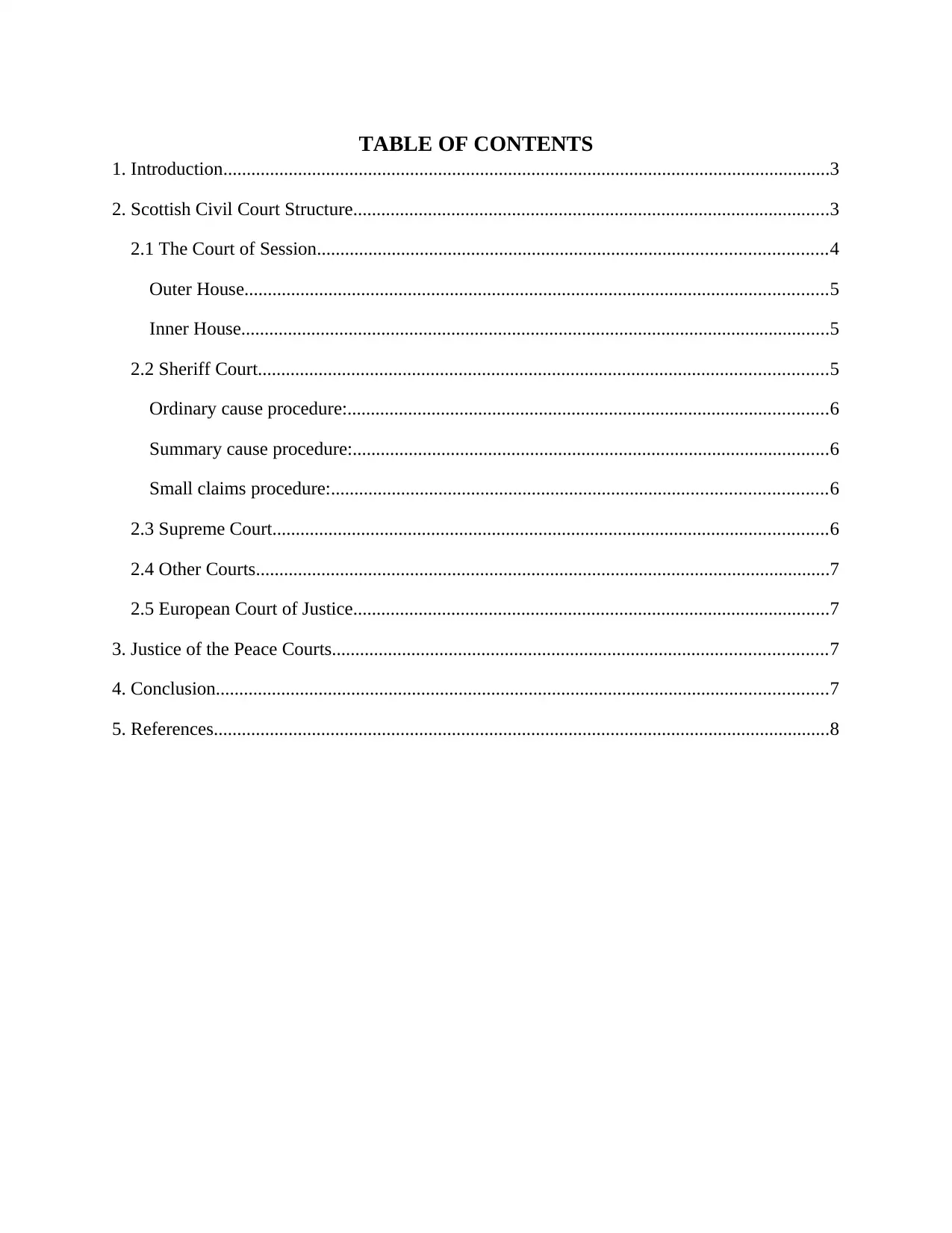
TABLE OF CONTENTS
1. Introduction..................................................................................................................................3
2. Scottish Civil Court Structure......................................................................................................3
2.1 The Court of Session.............................................................................................................4
Outer House.............................................................................................................................5
Inner House..............................................................................................................................5
2.2 Sheriff Court..........................................................................................................................5
Ordinary cause procedure:.......................................................................................................6
Summary cause procedure:......................................................................................................6
Small claims procedure:..........................................................................................................6
2.3 Supreme Court.......................................................................................................................6
2.4 Other Courts...........................................................................................................................7
2.5 European Court of Justice......................................................................................................7
3. Justice of the Peace Courts..........................................................................................................7
4. Conclusion...................................................................................................................................7
5. References....................................................................................................................................8
1. Introduction..................................................................................................................................3
2. Scottish Civil Court Structure......................................................................................................3
2.1 The Court of Session.............................................................................................................4
Outer House.............................................................................................................................5
Inner House..............................................................................................................................5
2.2 Sheriff Court..........................................................................................................................5
Ordinary cause procedure:.......................................................................................................6
Summary cause procedure:......................................................................................................6
Small claims procedure:..........................................................................................................6
2.3 Supreme Court.......................................................................................................................6
2.4 Other Courts...........................................................................................................................7
2.5 European Court of Justice......................................................................................................7
3. Justice of the Peace Courts..........................................................................................................7
4. Conclusion...................................................................................................................................7
5. References....................................................................................................................................8
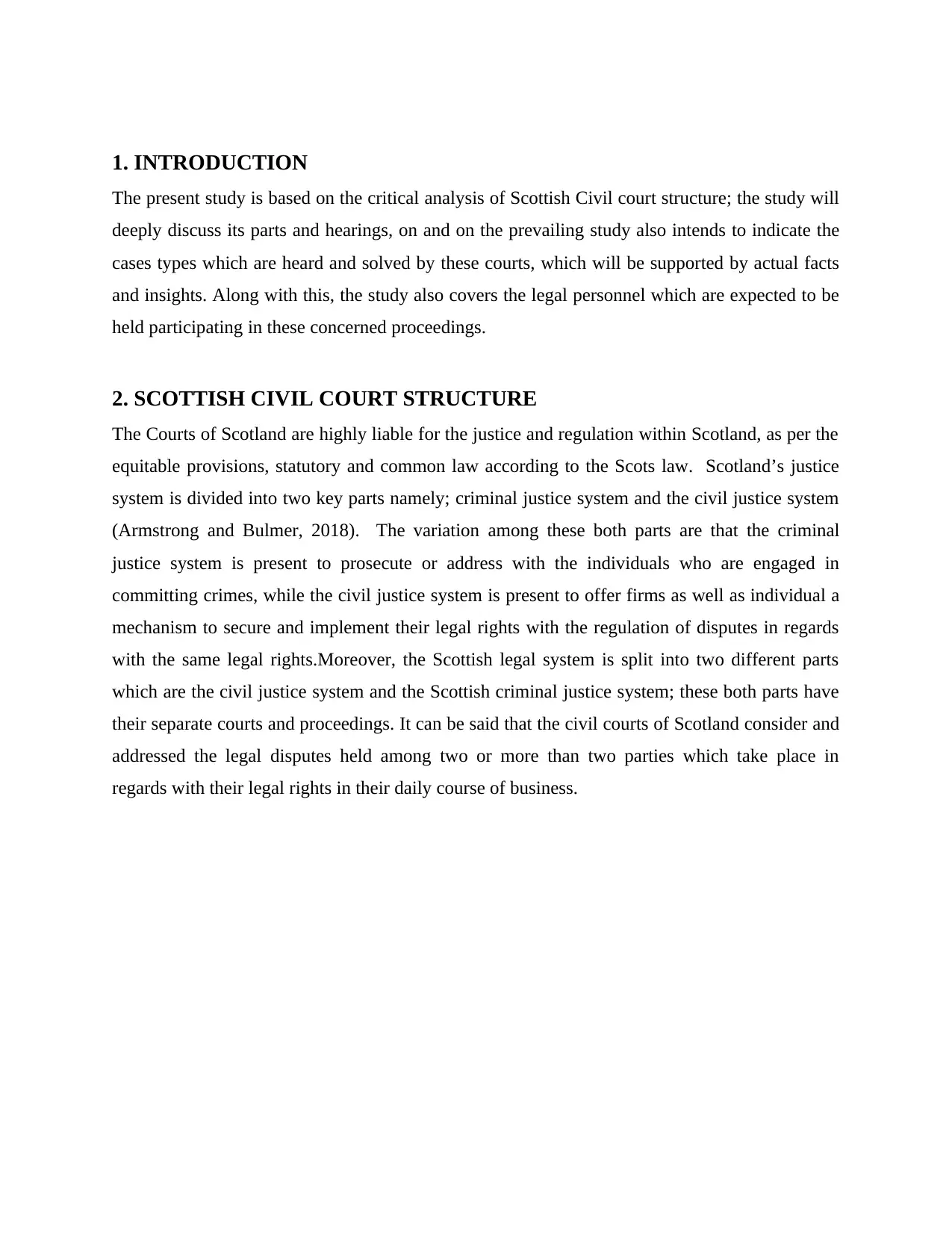
1. INTRODUCTION
The present study is based on the critical analysis of Scottish Civil court structure; the study will
deeply discuss its parts and hearings, on and on the prevailing study also intends to indicate the
cases types which are heard and solved by these courts, which will be supported by actual facts
and insights. Along with this, the study also covers the legal personnel which are expected to be
held participating in these concerned proceedings.
2. SCOTTISH CIVIL COURT STRUCTURE
The Courts of Scotland are highly liable for the justice and regulation within Scotland, as per the
equitable provisions, statutory and common law according to the Scots law. Scotland’s justice
system is divided into two key parts namely; criminal justice system and the civil justice system
(Armstrong and Bulmer, 2018). The variation among these both parts are that the criminal
justice system is present to prosecute or address with the individuals who are engaged in
committing crimes, while the civil justice system is present to offer firms as well as individual a
mechanism to secure and implement their legal rights with the regulation of disputes in regards
with the same legal rights.Moreover, the Scottish legal system is split into two different parts
which are the civil justice system and the Scottish criminal justice system; these both parts have
their separate courts and proceedings. It can be said that the civil courts of Scotland consider and
addressed the legal disputes held among two or more than two parties which take place in
regards with their legal rights in their daily course of business.
The present study is based on the critical analysis of Scottish Civil court structure; the study will
deeply discuss its parts and hearings, on and on the prevailing study also intends to indicate the
cases types which are heard and solved by these courts, which will be supported by actual facts
and insights. Along with this, the study also covers the legal personnel which are expected to be
held participating in these concerned proceedings.
2. SCOTTISH CIVIL COURT STRUCTURE
The Courts of Scotland are highly liable for the justice and regulation within Scotland, as per the
equitable provisions, statutory and common law according to the Scots law. Scotland’s justice
system is divided into two key parts namely; criminal justice system and the civil justice system
(Armstrong and Bulmer, 2018). The variation among these both parts are that the criminal
justice system is present to prosecute or address with the individuals who are engaged in
committing crimes, while the civil justice system is present to offer firms as well as individual a
mechanism to secure and implement their legal rights with the regulation of disputes in regards
with the same legal rights.Moreover, the Scottish legal system is split into two different parts
which are the civil justice system and the Scottish criminal justice system; these both parts have
their separate courts and proceedings. It can be said that the civil courts of Scotland consider and
addressed the legal disputes held among two or more than two parties which take place in
regards with their legal rights in their daily course of business.
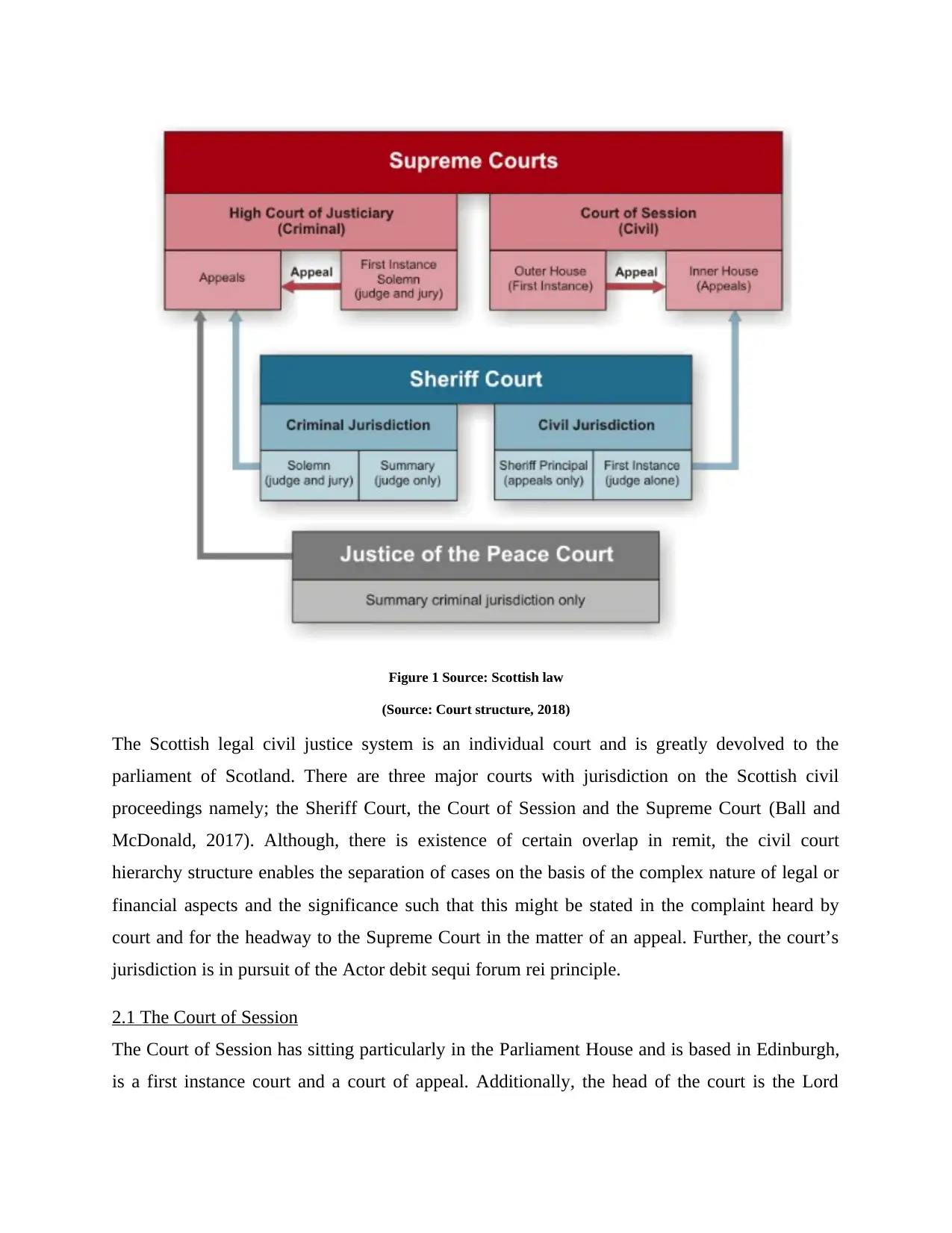
Figure 1 Source: Scottish law
(Source: Court structure, 2018)
The Scottish legal civil justice system is an individual court and is greatly devolved to the
parliament of Scotland. There are three major courts with jurisdiction on the Scottish civil
proceedings namely; the Sheriff Court, the Court of Session and the Supreme Court (Ball and
McDonald, 2017). Although, there is existence of certain overlap in remit, the civil court
hierarchy structure enables the separation of cases on the basis of the complex nature of legal or
financial aspects and the significance such that this might be stated in the complaint heard by
court and for the headway to the Supreme Court in the matter of an appeal. Further, the court’s
jurisdiction is in pursuit of the Actor debit sequi forum rei principle.
2.1 The Court of Session
The Court of Session has sitting particularly in the Parliament House and is based in Edinburgh,
is a first instance court and a court of appeal. Additionally, the head of the court is the Lord
(Source: Court structure, 2018)
The Scottish legal civil justice system is an individual court and is greatly devolved to the
parliament of Scotland. There are three major courts with jurisdiction on the Scottish civil
proceedings namely; the Sheriff Court, the Court of Session and the Supreme Court (Ball and
McDonald, 2017). Although, there is existence of certain overlap in remit, the civil court
hierarchy structure enables the separation of cases on the basis of the complex nature of legal or
financial aspects and the significance such that this might be stated in the complaint heard by
court and for the headway to the Supreme Court in the matter of an appeal. Further, the court’s
jurisdiction is in pursuit of the Actor debit sequi forum rei principle.
2.1 The Court of Session
The Court of Session has sitting particularly in the Parliament House and is based in Edinburgh,
is a first instance court and a court of appeal. Additionally, the head of the court is the Lord
Secure Best Marks with AI Grader
Need help grading? Try our AI Grader for instant feedback on your assignments.
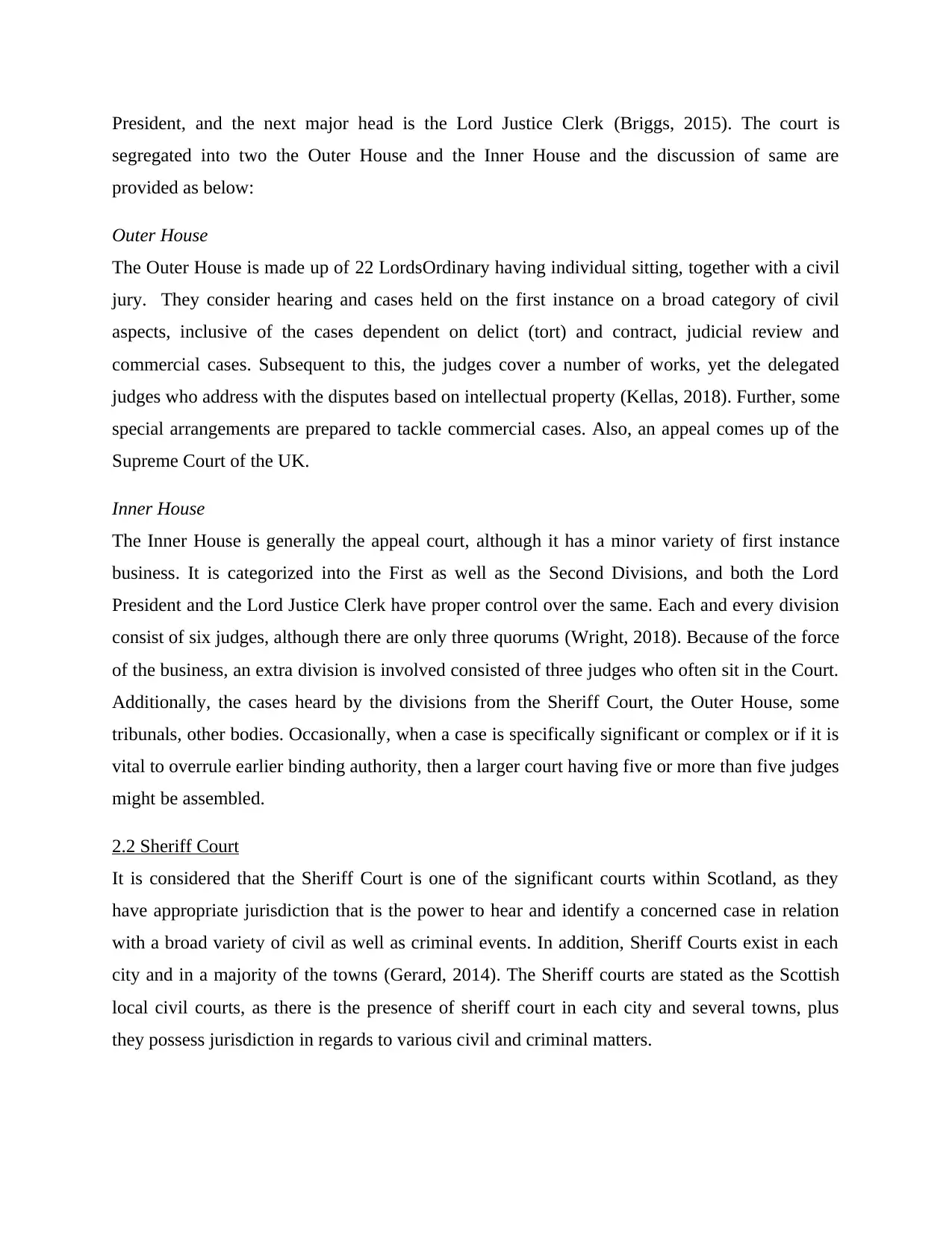
President, and the next major head is the Lord Justice Clerk (Briggs, 2015). The court is
segregated into two the Outer House and the Inner House and the discussion of same are
provided as below:
Outer House
The Outer House is made up of 22 LordsOrdinary having individual sitting, together with a civil
jury. They consider hearing and cases held on the first instance on a broad category of civil
aspects, inclusive of the cases dependent on delict (tort) and contract, judicial review and
commercial cases. Subsequent to this, the judges cover a number of works, yet the delegated
judges who address with the disputes based on intellectual property (Kellas, 2018). Further, some
special arrangements are prepared to tackle commercial cases. Also, an appeal comes up of the
Supreme Court of the UK.
Inner House
The Inner House is generally the appeal court, although it has a minor variety of first instance
business. It is categorized into the First as well as the Second Divisions, and both the Lord
President and the Lord Justice Clerk have proper control over the same. Each and every division
consist of six judges, although there are only three quorums (Wright, 2018). Because of the force
of the business, an extra division is involved consisted of three judges who often sit in the Court.
Additionally, the cases heard by the divisions from the Sheriff Court, the Outer House, some
tribunals, other bodies. Occasionally, when a case is specifically significant or complex or if it is
vital to overrule earlier binding authority, then a larger court having five or more than five judges
might be assembled.
2.2 Sheriff Court
It is considered that the Sheriff Court is one of the significant courts within Scotland, as they
have appropriate jurisdiction that is the power to hear and identify a concerned case in relation
with a broad variety of civil as well as criminal events. In addition, Sheriff Courts exist in each
city and in a majority of the towns (Gerard, 2014). The Sheriff courts are stated as the Scottish
local civil courts, as there is the presence of sheriff court in each city and several towns, plus
they possess jurisdiction in regards to various civil and criminal matters.
segregated into two the Outer House and the Inner House and the discussion of same are
provided as below:
Outer House
The Outer House is made up of 22 LordsOrdinary having individual sitting, together with a civil
jury. They consider hearing and cases held on the first instance on a broad category of civil
aspects, inclusive of the cases dependent on delict (tort) and contract, judicial review and
commercial cases. Subsequent to this, the judges cover a number of works, yet the delegated
judges who address with the disputes based on intellectual property (Kellas, 2018). Further, some
special arrangements are prepared to tackle commercial cases. Also, an appeal comes up of the
Supreme Court of the UK.
Inner House
The Inner House is generally the appeal court, although it has a minor variety of first instance
business. It is categorized into the First as well as the Second Divisions, and both the Lord
President and the Lord Justice Clerk have proper control over the same. Each and every division
consist of six judges, although there are only three quorums (Wright, 2018). Because of the force
of the business, an extra division is involved consisted of three judges who often sit in the Court.
Additionally, the cases heard by the divisions from the Sheriff Court, the Outer House, some
tribunals, other bodies. Occasionally, when a case is specifically significant or complex or if it is
vital to overrule earlier binding authority, then a larger court having five or more than five judges
might be assembled.
2.2 Sheriff Court
It is considered that the Sheriff Court is one of the significant courts within Scotland, as they
have appropriate jurisdiction that is the power to hear and identify a concerned case in relation
with a broad variety of civil as well as criminal events. In addition, Sheriff Courts exist in each
city and in a majority of the towns (Gerard, 2014). The Sheriff courts are stated as the Scottish
local civil courts, as there is the presence of sheriff court in each city and several towns, plus
they possess jurisdiction in regards to various civil and criminal matters.
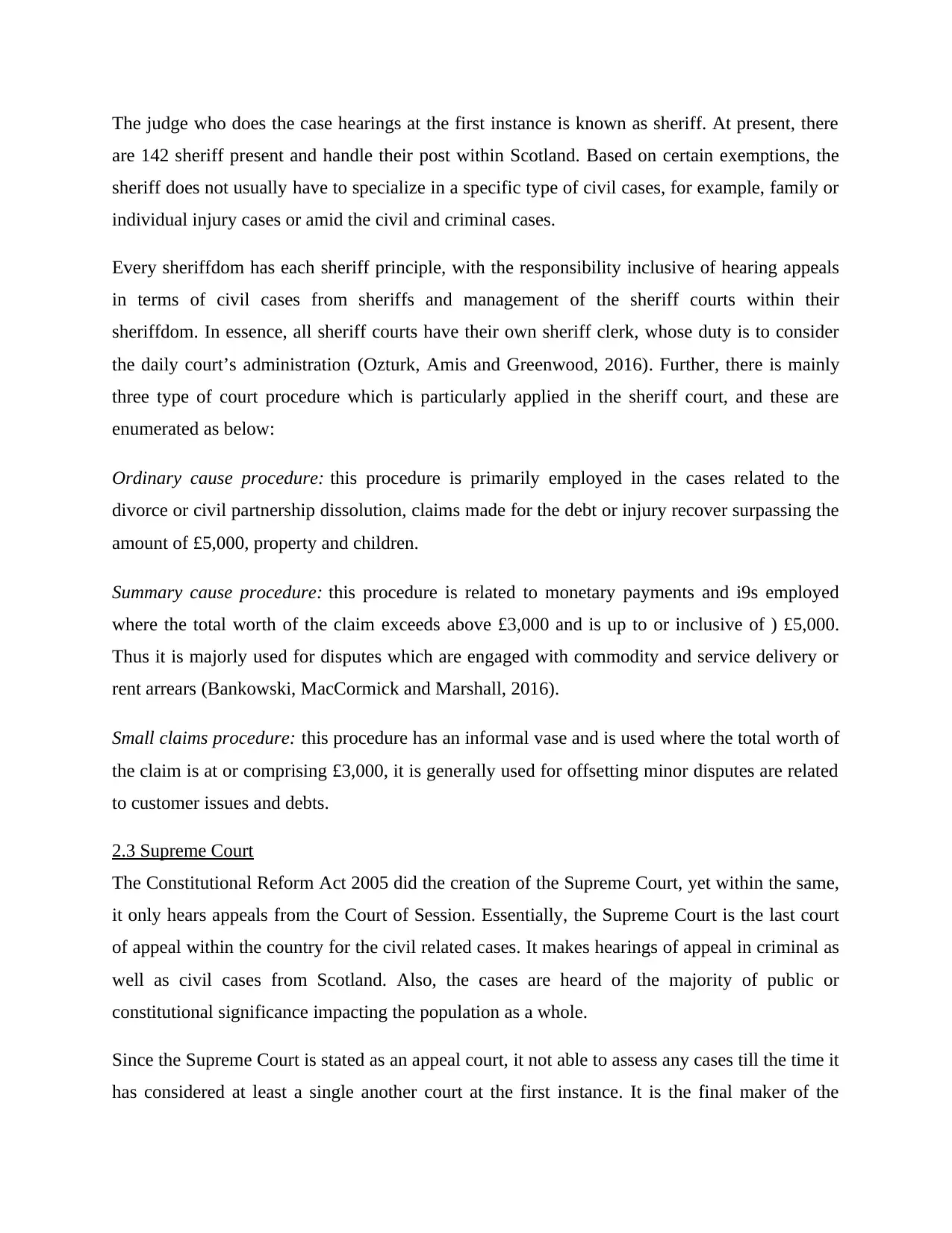
The judge who does the case hearings at the first instance is known as sheriff. At present, there
are 142 sheriff present and handle their post within Scotland. Based on certain exemptions, the
sheriff does not usually have to specialize in a specific type of civil cases, for example, family or
individual injury cases or amid the civil and criminal cases.
Every sheriffdom has each sheriff principle, with the responsibility inclusive of hearing appeals
in terms of civil cases from sheriffs and management of the sheriff courts within their
sheriffdom. In essence, all sheriff courts have their own sheriff clerk, whose duty is to consider
the daily court’s administration (Ozturk, Amis and Greenwood, 2016). Further, there is mainly
three type of court procedure which is particularly applied in the sheriff court, and these are
enumerated as below:
Ordinary cause procedure: this procedure is primarily employed in the cases related to the
divorce or civil partnership dissolution, claims made for the debt or injury recover surpassing the
amount of £5,000, property and children.
Summary cause procedure: this procedure is related to monetary payments and i9s employed
where the total worth of the claim exceeds above £3,000 and is up to or inclusive of ) £5,000.
Thus it is majorly used for disputes which are engaged with commodity and service delivery or
rent arrears (Bankowski, MacCormick and Marshall, 2016).
Small claims procedure: this procedure has an informal vase and is used where the total worth of
the claim is at or comprising £3,000, it is generally used for offsetting minor disputes are related
to customer issues and debts.
2.3 Supreme Court
The Constitutional Reform Act 2005 did the creation of the Supreme Court, yet within the same,
it only hears appeals from the Court of Session. Essentially, the Supreme Court is the last court
of appeal within the country for the civil related cases. It makes hearings of appeal in criminal as
well as civil cases from Scotland. Also, the cases are heard of the majority of public or
constitutional significance impacting the population as a whole.
Since the Supreme Court is stated as an appeal court, it not able to assess any cases till the time it
has considered at least a single another court at the first instance. It is the final maker of the
are 142 sheriff present and handle their post within Scotland. Based on certain exemptions, the
sheriff does not usually have to specialize in a specific type of civil cases, for example, family or
individual injury cases or amid the civil and criminal cases.
Every sheriffdom has each sheriff principle, with the responsibility inclusive of hearing appeals
in terms of civil cases from sheriffs and management of the sheriff courts within their
sheriffdom. In essence, all sheriff courts have their own sheriff clerk, whose duty is to consider
the daily court’s administration (Ozturk, Amis and Greenwood, 2016). Further, there is mainly
three type of court procedure which is particularly applied in the sheriff court, and these are
enumerated as below:
Ordinary cause procedure: this procedure is primarily employed in the cases related to the
divorce or civil partnership dissolution, claims made for the debt or injury recover surpassing the
amount of £5,000, property and children.
Summary cause procedure: this procedure is related to monetary payments and i9s employed
where the total worth of the claim exceeds above £3,000 and is up to or inclusive of ) £5,000.
Thus it is majorly used for disputes which are engaged with commodity and service delivery or
rent arrears (Bankowski, MacCormick and Marshall, 2016).
Small claims procedure: this procedure has an informal vase and is used where the total worth of
the claim is at or comprising £3,000, it is generally used for offsetting minor disputes are related
to customer issues and debts.
2.3 Supreme Court
The Constitutional Reform Act 2005 did the creation of the Supreme Court, yet within the same,
it only hears appeals from the Court of Session. Essentially, the Supreme Court is the last court
of appeal within the country for the civil related cases. It makes hearings of appeal in criminal as
well as civil cases from Scotland. Also, the cases are heard of the majority of public or
constitutional significance impacting the population as a whole.
Since the Supreme Court is stated as an appeal court, it not able to assess any cases till the time it
has considered at least a single another court at the first instance. It is the final maker of the
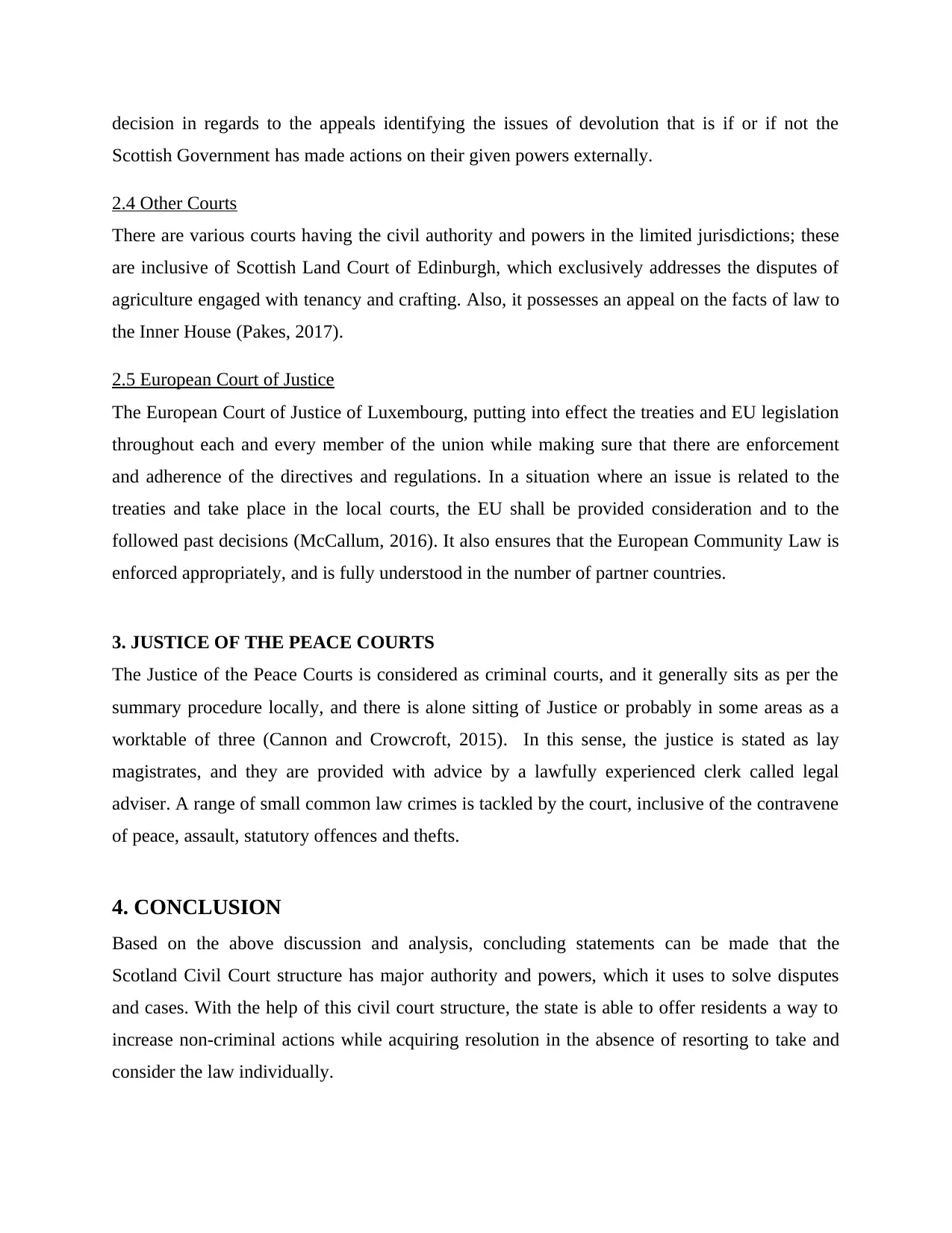
decision in regards to the appeals identifying the issues of devolution that is if or if not the
Scottish Government has made actions on their given powers externally.
2.4 Other Courts
There are various courts having the civil authority and powers in the limited jurisdictions; these
are inclusive of Scottish Land Court of Edinburgh, which exclusively addresses the disputes of
agriculture engaged with tenancy and crafting. Also, it possesses an appeal on the facts of law to
the Inner House (Pakes, 2017).
2.5 European Court of Justice
The European Court of Justice of Luxembourg, putting into effect the treaties and EU legislation
throughout each and every member of the union while making sure that there are enforcement
and adherence of the directives and regulations. In a situation where an issue is related to the
treaties and take place in the local courts, the EU shall be provided consideration and to the
followed past decisions (McCallum, 2016). It also ensures that the European Community Law is
enforced appropriately, and is fully understood in the number of partner countries.
3. JUSTICE OF THE PEACE COURTS
The Justice of the Peace Courts is considered as criminal courts, and it generally sits as per the
summary procedure locally, and there is alone sitting of Justice or probably in some areas as a
worktable of three (Cannon and Crowcroft, 2015). In this sense, the justice is stated as lay
magistrates, and they are provided with advice by a lawfully experienced clerk called legal
adviser. A range of small common law crimes is tackled by the court, inclusive of the contravene
of peace, assault, statutory offences and thefts.
4. CONCLUSION
Based on the above discussion and analysis, concluding statements can be made that the
Scotland Civil Court structure has major authority and powers, which it uses to solve disputes
and cases. With the help of this civil court structure, the state is able to offer residents a way to
increase non-criminal actions while acquiring resolution in the absence of resorting to take and
consider the law individually.
Scottish Government has made actions on their given powers externally.
2.4 Other Courts
There are various courts having the civil authority and powers in the limited jurisdictions; these
are inclusive of Scottish Land Court of Edinburgh, which exclusively addresses the disputes of
agriculture engaged with tenancy and crafting. Also, it possesses an appeal on the facts of law to
the Inner House (Pakes, 2017).
2.5 European Court of Justice
The European Court of Justice of Luxembourg, putting into effect the treaties and EU legislation
throughout each and every member of the union while making sure that there are enforcement
and adherence of the directives and regulations. In a situation where an issue is related to the
treaties and take place in the local courts, the EU shall be provided consideration and to the
followed past decisions (McCallum, 2016). It also ensures that the European Community Law is
enforced appropriately, and is fully understood in the number of partner countries.
3. JUSTICE OF THE PEACE COURTS
The Justice of the Peace Courts is considered as criminal courts, and it generally sits as per the
summary procedure locally, and there is alone sitting of Justice or probably in some areas as a
worktable of three (Cannon and Crowcroft, 2015). In this sense, the justice is stated as lay
magistrates, and they are provided with advice by a lawfully experienced clerk called legal
adviser. A range of small common law crimes is tackled by the court, inclusive of the contravene
of peace, assault, statutory offences and thefts.
4. CONCLUSION
Based on the above discussion and analysis, concluding statements can be made that the
Scotland Civil Court structure has major authority and powers, which it uses to solve disputes
and cases. With the help of this civil court structure, the state is able to offer residents a way to
increase non-criminal actions while acquiring resolution in the absence of resorting to take and
consider the law individually.
Paraphrase This Document
Need a fresh take? Get an instant paraphrase of this document with our AI Paraphraser
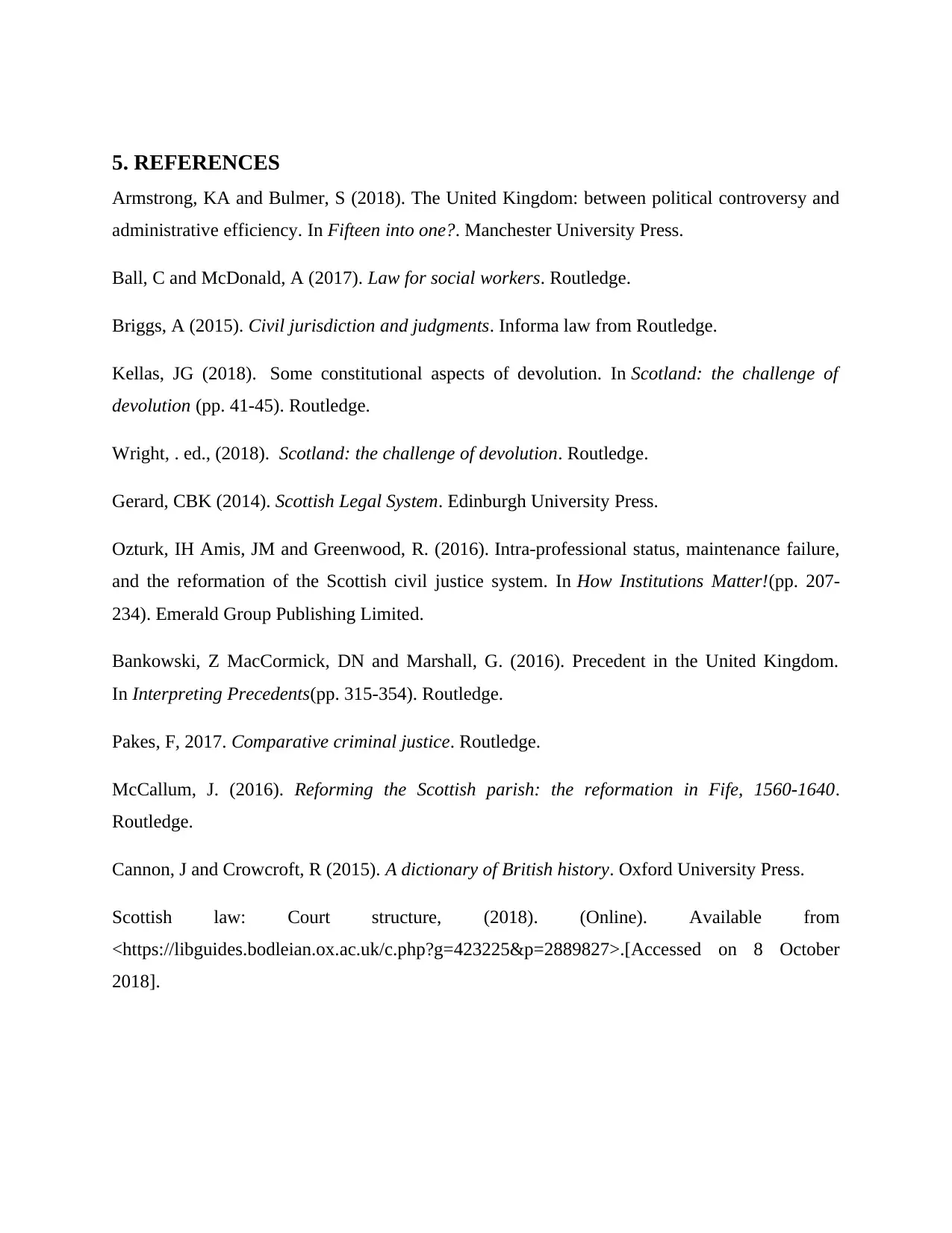
5. REFERENCES
Armstrong, KA and Bulmer, S (2018). The United Kingdom: between political controversy and
administrative efficiency. In Fifteen into one?. Manchester University Press.
Ball, C and McDonald, A (2017). Law for social workers. Routledge.
Briggs, A (2015). Civil jurisdiction and judgments. Informa law from Routledge.
Kellas, JG (2018). Some constitutional aspects of devolution. In Scotland: the challenge of
devolution (pp. 41-45). Routledge.
Wright, . ed., (2018). Scotland: the challenge of devolution. Routledge.
Gerard, CBK (2014). Scottish Legal System. Edinburgh University Press.
Ozturk, IH Amis, JM and Greenwood, R. (2016). Intra-professional status, maintenance failure,
and the reformation of the Scottish civil justice system. In How Institutions Matter!(pp. 207-
234). Emerald Group Publishing Limited.
Bankowski, Z MacCormick, DN and Marshall, G. (2016). Precedent in the United Kingdom.
In Interpreting Precedents(pp. 315-354). Routledge.
Pakes, F, 2017. Comparative criminal justice. Routledge.
McCallum, J. (2016). Reforming the Scottish parish: the reformation in Fife, 1560-1640.
Routledge.
Cannon, J and Crowcroft, R (2015). A dictionary of British history. Oxford University Press.
Scottish law: Court structure, (2018). (Online). Available from
<https://libguides.bodleian.ox.ac.uk/c.php?g=423225&p=2889827>.[Accessed on 8 October
2018].
Armstrong, KA and Bulmer, S (2018). The United Kingdom: between political controversy and
administrative efficiency. In Fifteen into one?. Manchester University Press.
Ball, C and McDonald, A (2017). Law for social workers. Routledge.
Briggs, A (2015). Civil jurisdiction and judgments. Informa law from Routledge.
Kellas, JG (2018). Some constitutional aspects of devolution. In Scotland: the challenge of
devolution (pp. 41-45). Routledge.
Wright, . ed., (2018). Scotland: the challenge of devolution. Routledge.
Gerard, CBK (2014). Scottish Legal System. Edinburgh University Press.
Ozturk, IH Amis, JM and Greenwood, R. (2016). Intra-professional status, maintenance failure,
and the reformation of the Scottish civil justice system. In How Institutions Matter!(pp. 207-
234). Emerald Group Publishing Limited.
Bankowski, Z MacCormick, DN and Marshall, G. (2016). Precedent in the United Kingdom.
In Interpreting Precedents(pp. 315-354). Routledge.
Pakes, F, 2017. Comparative criminal justice. Routledge.
McCallum, J. (2016). Reforming the Scottish parish: the reformation in Fife, 1560-1640.
Routledge.
Cannon, J and Crowcroft, R (2015). A dictionary of British history. Oxford University Press.
Scottish law: Court structure, (2018). (Online). Available from
<https://libguides.bodleian.ox.ac.uk/c.php?g=423225&p=2889827>.[Accessed on 8 October
2018].

1 out of 9
Related Documents
Your All-in-One AI-Powered Toolkit for Academic Success.
+13062052269
info@desklib.com
Available 24*7 on WhatsApp / Email
![[object Object]](/_next/static/media/star-bottom.7253800d.svg)
Unlock your academic potential
© 2024 | Zucol Services PVT LTD | All rights reserved.




